Papers by paratibha aggarwal
Iranian Journal of Science and Technology, Transactions of Civil Engineering
Iranian Journal of Science and Technology, Transactions of Civil Engineering
Journal of Irrigation and Drainage Engineering
IOP Conference Series: Materials Science and Engineering
This paper consists of a detailed analysis of the use of industrial by-products(coal bottom ash a... more This paper consists of a detailed analysis of the use of industrial by-products(coal bottom ash and fly ash) as an admixture in the self-compacting concrete. The judicious use of industrial byproducts and the proper waste management can lead to a sustainable development in the field of infrastructure. This paper talks about the physical and chemical properties of these by products used in the self-compacting concrete. Critical and definite analysis has been carried out on the reviewed literature and further scope of work in the analysis and interpretation has been addressed. On a positive note, it can be stated that the use of industrial by-products in self-compacting concrete can lead to a sustainable development.
Computers and Concrete, Aug 1, 2018
Self-Compacting Concrete: Materials, Properties and Applications, 2020
Abstract The chapter includes durability aspects of SCC such as carbonation and corrosion particu... more Abstract The chapter includes durability aspects of SCC such as carbonation and corrosion particularly chloride attack and sulphate attack. Carbonation in SCC is different from normal concrete, although a type i.e. natural and accelerated remains same as for conventional concrete. The difference is observed in reactions and mechanisms. Corrosion in SCC can be due to many causes but main are chloride attack and sulphate attack. Also, mechanism and factors of carbonation and corrosion change when supplementary cementitious materials are added to SCC.
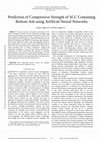
The paper presents a comparative performance of the models developed to predict 28 days compressi... more The paper presents a comparative performance of the models developed to predict 28 days compressive strengths using neural network techniques for data taken from literature (ANN-I) and data developed experimentally for SCC containing bottom ash as partial replacement of fine aggregates (ANN-II). The data used in the models are arranged in the format of six and eight input parameters that cover the contents of cement, sand, coarse aggregate, fly ash as partial replacement of cement, bottom ash as partial replacement of sand, water and water/powder ratio, superplasticizer dosage and an output parameter that is 28-days compressive strength and compressive strengths at 7 days, 28 days, 90 days and 365 days, respectively for ANN-I and ANN-II. The importance of different input parameters is also given for predicting the strengths at various ages using neural network. The model developed from literature data could be easily extended to the experimental data, with bottom ash as partial repl...

Integrated Approaches Towards Solid Waste Management, 2021
The generation of industrial wastes is increasing at a faster rate with the growth of the industr... more The generation of industrial wastes is increasing at a faster rate with the growth of the industries; and safe disposal of these wastes has become the main concern of the society. The wastes are directly dumped into open land areas or in watercourses, which pollute the air, land and water. Also, the cost of transportation is an additional burden to the industries. Like other industries, stone industry is an important construction industry and stone is the main building material. India is the third-largest country in stone production. A variety of stones, i.e. marble, limestone, granite, Kota stone etc. are available in India. A large amount of waste is produced during the processing of stones. This waste can be stone pieces, blocks, dust, slurry etc. and is directly dumped into open areas, which causes problems to the environment. This needs safe disposal of stone waste to avoid these environmental problems (Rajamane et al., 2011; Singh et al., 2018; Devi et al., 2018b). In the agreement of the Kyoto Protocol, all the big industries around the world are adopting policies, which encourage reduction in emission of greenhouse gases. The possible way is to reuse the industrial by products in various applications. The construction industry should take a step forward for the sustainable production by utilising various industrial wastes in cement-based materials as a substitution to cement or aggregates. This will conserve the natural raw materials and decrease the nuisance occurring due to disposal problems of waste or by-products (Kabeer and Vyas, 2019).
Excellence in Concrete Construction through Innovation, 2008

Lecture Notes in Civil Engineering, 2018
Accelerating admixtures have an important role in the construction industries to speed up the wor... more Accelerating admixtures have an important role in the construction industries to speed up the work by reducing setting time. Portland cement is an important ingredient in the mortar and concrete production. Large amount of CO2 is emitted during the manufacturing of cement. To minimize the CO2 emission up to some extent; industrial by-products can be utilised in concrete as replacement of cement. The stone slurry powder from stone industries has been used as replacement of cement in the present study. Calcium nitrate (1%), triethanolamine (0.025% and 0.1%) as additive and stone slurry powder (5%, 7.5% and 10%) as a replacement of cement was used. Consistency, setting time of cement paste; and compressive strength of the mortar using these materials was studied experimentally. Results showed that consistency increased; but, setting time of the cement paste decreased in comparison to the control mix. Calcium nitrate and stone slurry powder increased the compressive strength while TEA reduced the compressive strength of the cement mortar in comparison to control mix.

Soft computing techniques, i.e., linear regression, artificial neural network, genetic expression... more Soft computing techniques, i.e., linear regression, artificial neural network, genetic expression programming, etc., are being practiced for the prediction of data. In this study, artificial neural network model predicted the consistency, setting time, and compressive strength of mortar at various curing time. The eighteen distinct mix proportions of cement mortar consisting of accelerators, i.e., calcium nitrate and triethanolamine as additives and stone powder as replacement of cement were selected for the prediction of various parameters. The accelerators are used to fasten the stiffening of cementitious materials and speed up the construction work. Stone powder was used to minimize the consumption of cement and problems associated with waste to the ecosystem. The laboratory data set was used for the prediction model. The appropriate artificial neural network model constitutes mix constituents as input parameters, i.e., cement, sand, water, and additional materials. The results f...
The chapter includes strength properties including compressive strength, split tensile strength a... more The chapter includes strength properties including compressive strength, split tensile strength and flexural strength, correlation between compressive strength and split tensile strength and correlation between compressive strength and flexural strength of SCC. Influence of water powder ratio on compressive strength has been highlighted with graphs. The effect of elevated temperature on mechanical properties has also been discussed along with effect of supplementary cementitious materials (SCM) on strengths and their correlations.

Computers and Concrete, 2019
Recent advances in the concrete technology are aiding in minimizing the use of conventional mater... more Recent advances in the concrete technology are aiding in minimizing the use of conventional materials by substituting by-products of various industries and energy sources. A large amount of stone waste i.e., dust and slurry form both are being originated during natural stone processing and causing deadily effects on the environment. The disposal problem of stone waste can be resolved effectively by using waste in construction industries. In present work, Kota stone slurry powder, as a substitution of cement was used along with accelerators namely calcium nitrate and triethanolamine as additives, to study their impact on various properties of the concrete mixtures. Kota stone slurry powder (7.5%), calcium nitrate (1%) and triethanolamine (0.05%) were used separately as well in combination in different concrete mixtures. Mechanical Strength, modulus of elasticity and electrical resistivity of concrete specimens of different mix proportions under water curing were studied experimentall...

Self-compacting concrete can be defined as the concrete which requires no vibrations and can flow... more Self-compacting concrete can be defined as the concrete which requires no vibrations and can flow around obstructions, encloses the reinforcement and fills up the formwork completely under its self weight. Over the last ten years, significant amount of work has been carried out on self-compacting concrete all over the world. In countries like Japan, Sweden, Thailand, UK etc., the knowledge of SCC has moved from domain of research to application. The paper discusses the existing level of research about various aspects of selfcompacting concrete, including materials and mixture design, test methods such as Vfunnel test, L-Box test, J-ring etc., construction-related issues like Tribological behavior of SCC, performance of SCC for under water applications , in basement walls, columns, beams etc., and properties including fresh concrete properties like slump flow, segregation resistance, compressive strength, permeability and diffusivity. Durability properties like sulfate resistance, in...
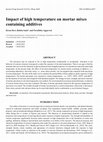
Journal of Engineering Research, 2021
The structures may be exposed to fire or high temperature conditionally or accidentally. Alterati... more The structures may be exposed to fire or high temperature conditionally or accidentally. Alteration in the behavior of concrete structure is prospective under the exposure of elevated temperature. There is an urge to find the materials which can resist the alteration in physiochemical and strength properties of cementitious materials under high temperature. In the present study, the effect of elevated temperature on cement mortar consisting of additives i.e. accelerating admixtures, and stone waste i.e. stone slurry powder, was investigated and compared with specimens at room temperature. The aim of study was to examine the practicability of these additives under exposure to high temperatures. The mortar specimens were exposed to various temperatures i.e. 1500C, 3000C, 4500C and 6000C for the duration of one hour and compared with unheated samples. The change in mass, strength and micro-structure of mortar specimens at elevated temperature was studied. The environmental assessment a...
Construction and Building Materials, 2020
h i g h l i g h t s Characterisation of waste foundry sand using XRD, TGA-DTG and SEM. Utilisatio... more h i g h l i g h t s Characterisation of waste foundry sand using XRD, TGA-DTG and SEM. Utilisation of waste foundry sand for natural fine aggregate replacement. Fresh and hardened properties of self-compacting concrete containing waste foundry sand. Water permeability and sorptivity using autoclam apparatus.
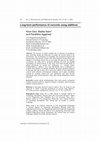
International Journal of Microstructure and Materials Properties, 2020
The increase in global warming due to emission of greenhouse gases especially during the producti... more The increase in global warming due to emission of greenhouse gases especially during the production of cement has become threat to the environment. The development of sustainable and economical materials has become need of the present scenario. Also, direct disposal of waste from stone industries is becoming serious issue to ecosystem and need its safe disposal. Accelerators are being used to accelerate stiffening and early age strength development of mortar/concrete. In this study, Kota stone powder (KSP) as partial substitution to cement and admixtures, i.e., calcium nitrate, triethanolamine as additives were used individually and in combination to examine their influence on strength, durability and micro-structural properties at later age. The aim of study was to check the viability of these materials in concrete under different environmental conditions; and to make sustainable concrete by reducing cement and cost. Admixtures and stone powder individually improved the properties; while, their mixture diminished concrete properties.
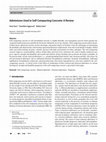
Iranian Journal of Science and Technology, Transactions of Civil Engineering, 2019
Self-compacting concrete or self-consolidated concrete is a highly flowable, non-segregating conc... more Self-compacting concrete or self-consolidated concrete is a highly flowable, non-segregating concrete which spreads into congested reinforcement area and fills the formwork without the use of any vibrators. Self-compacting concrete allows denser reinforcement, optimized concrete section and shapes, and greater degree of freedom. It has the advantages of maintaining the durability and characteristics and meeting expected performance requirements. It has been used ideally in bridges, drilled shaft, and earth-retaining structure, columns and area with high concentration of rebars and pipes. The self-compacting concrete improves constructability, reduces skilled labor and noise level, minimizes the voids in highly reinforced area, gives superior strength and durability and smooth and uniform surface finishing and accelerates the project schedules. In the present study, various mineral admixtures, i.e., ground-granulated blast-furnace slag, limestone powder, silica fume, fly ash and chemical admixtures such as sulfonated melamine formaldehyde condensate, melamine formaldehyde, sulfonated naphthalene formaldehyde condensates and polycarboxylate ether-based superplasticizer, have been studied in the selfcompacting concrete. A critical review of the effect of combination of these mineral and chemical admixtures on various rheological, strength and durability properties of the self-compacting concrete is presented in this paper.

Computers and Concrete, 2008
ABSTRACT The paper explores the potential of Support Vector Machines (SVM) approach in predicting... more ABSTRACT The paper explores the potential of Support Vector Machines (SVM) approach in predicting 28-day compressive strength and slump flow of self-compacting concrete. Total of 80 data collected from the exiting literature were used in present work. To compare the performance of the technique, prediction was also done using a back propagation neural network model. For this data-set, RBF kernel worked well in comparison to polynomial kernel based support vector machines and provide a root mean square error of 4.688 (MPa) (correlation coefficient=0.942) for 28-day compressive strength prediction and a root mean square error of 7.825 cm (correlation coefficient=0.931) for slump flow. Results obtained for RMSE and correlation coefficient suggested a comparable performance by Support Vector Machine approach to neural network approach for both 28-day compressive strength and slump flow prediction.









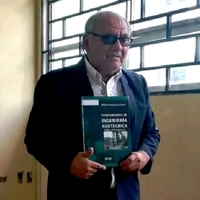

Uploads
Papers by paratibha aggarwal